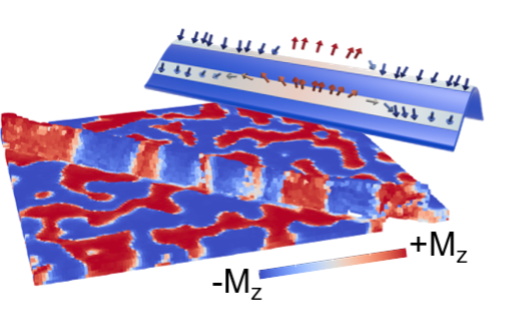Curvature Induced Magnetism
Posted in News Story
Magnetic memory and computing devices have long been built in flat, two-dimensional designs. Now, researchers have shown that adding curvature to three-dimensional (3D) magnetic nanostructures can give scientists a new level of control over magnetic behavior—potentially paving the way for faster, more efficient next-generation technologies.
A Georgetown University team, led by postdoctoral fellow Dhritiman Bhattacharya and graduate students Colin Langton and Bradley Fugetta, has demonstrated how bending thin magnetic films can change the way the tiny magnetic regions inside them are arranged. Their work provides direct experimental evidence that curvature can induce a “handedness,” or chirality, in magnetic patterns—a finding that could be a game-changer for spintronics, a field that uses electron spin to store and process information.
The project was a collaboration between Professor Kai Liu’s group in Georgetown’s Department of Physics and Dr. Peter Fischer’s team at Lawrence Berkeley National Laboratory (LBNL) and the University of California, Santa Cruz (UCSC). The findings were just published in ACS Nano.
To explore the effect of curvature, the Georgetown researchers synthesized cobalt/palladium (Co/Pd) multilayer films that naturally prefer magnetization pointing out of the film surface. They deposited these films onto copper nanowire meshes—each wire just 50 nanometers wide and several microns long—creating a nanoscale curved surface on top of silicon nitride membranes. The LBNL/UCSC researchers, led by senior graduate student David Raftrey, performed advanced magnetic soft X-ray nanotomography at the ALBA Light Source in Barcelona, Spain, together with graduate student Olha Beszmertna from Dr. Denys Makarov’s group at the Helmholtz-Zentrum Dresden-Rossendorf in Germany and with support from the local beamline scientist Dr. Andrea Sorrentino. The team was able to reconstruct the 3D magnetic configurations in the films with extraordinary detail—down to 30 nanometers in spatial resolution and 9 nanometers in voxel size.
The team’s curved design, combined with state-of-the-art 3D-imaging, revealed fascinating ways that shape can influence magnetism. In these Co/Pd multilayer films, the internal magnetic alignment tended to follow the curve of the surface—pointing in the direction perpendicular to it. Unlike flat films, which typically form maze-like magnetic patterns, the curved nanowires promoted the magnetic domains nearby to line up along the length of the wire, while those farther away kept more random orientations.
Even more striking, the researchers observed that curvature can trigger a special magnetic effect known as the Dzyaloshinskii–Moriya interaction (DMI). This effect is important because it helps create and stabilize exotic magnetic structures that have topological characters and are essential building blocks for future spintronic devices. The team discovered that the domain walls in the Co/Pd film on top of the nanowire are of the Néel-type with a preferred rotation sense, and estimated that the curvature-induced DMI was about one-third as strong as the intrinsic DMI found in flat Co/Pd stacks. Micromagnetic simulations, performed in collaboration with Prof. Gen Yin at Georgetown University, supported these findings. The analysis of the data also benefited from the expertise of Dr. Subhashree Satapathy of LBNL.
These findings show that simply shaping a magnetic material in 3D can dramatically change its behavior—a concept that could be key to developing ultra-fast, high-density 3D racetrack memory and brain-inspired (neuromorphic) computing technologies.
This research was supported in part by the National Science Foundation and the Department of Energy.

